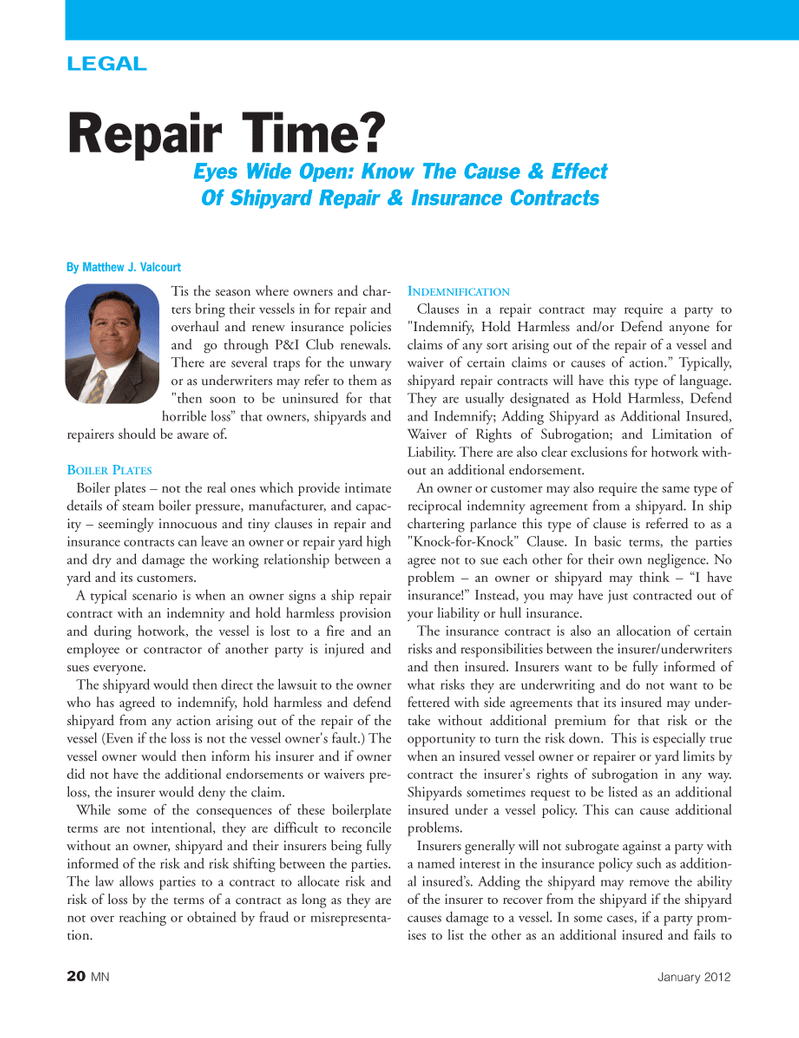
Page 20: of Marine News Magazine (January 2012)
Vessel Construction & Repair
Read this page in Pdf, Flash or Html5 edition of January 2012 Marine News Magazine
20MNJanuary 2012 LEGALTis the season where owners and char- ters bring their vessels in for repair and overhaul and renew insurance policies and go through P&I Club renewals. There are several traps for the unwary or as underwriters may refer to them as "then soon to be uninsured for that horrible loss? that owners, shipyards and repairers should be aware of. BOILERPLATES Boiler plates ? not the real ones which provide intimate details of steam boiler pressure, manufacturer, and capac- ity ? seemingly innocuous and tiny clauses in repair and insurance contracts can leave an owner or repair yard high and dry and damage the working relationship between a yard and its customers. A typical scenario is when an owner signs a ship repair contract with an indemnity and hold harmless provision and during hotwork, the vessel is lost to a fire and an employee or contractor of another party is injured and sues everyone. The shipyard would then direct the lawsuit to the owner who has agreed to indemnify, hold harmless and defend shipyard from any action arising out of the repair of the vessel (Even if the loss is not the vessel owner's fault.) The vessel owner would then inform his insurer and if owner did not have the additional endorsements or waivers pre- loss, the insurer would deny the claim. While some of the consequences of these boilerplateterms are not intentional, they are difficult to reconcile without an owner, shipyard and their insurers being fully informed of the risk and risk shifting between the parties. The law allows parties to a contract to allocate risk and risk of loss by the terms of a contract as long as they are not over reaching or obtained by fraud or misrepresenta- tion.INDEMNIFICATION Clauses in a repair contract may require a party to "Indemnify, Hold Harmless and/or Defend anyone for claims of any sort arising out of the repair of a vessel and waiver of certain claims or causes of action.? Typically, shipyard repair contracts will have this type of language. They are usually designated as Hold Harmless, Defend and Indemnify; Adding Shipyard as Additional Insured, Waiver of Rights of Subrogation; and Limitation of Liability. There are also clear exclusions for hotwork with- out an additional endorsement.An owner or customer may also require the same type of reciprocal indemnity agreement from a shipyard. In ship chartering parlance this type of clause is referred to as a "Knock-for-Knock" Clause. In basic terms, the parties agree not to sue each other for their own negligence. No problem ? an owner or shipyard may think ? ?I have insurance!? Instead, you may have just contracted out of your liability or hull insurance. The insurance contract is also an allocation of certain risks and responsibilities between the insurer/underwriters and then insured. Insurers want to be fully informed of what risks they are underwriting and do not want to be fettered with side agreements that its insured may under- take without additional premium for that risk or the opportunity to turn the risk down. This is especially true when an insured vessel owner or repairer or yard limits by contract the insurer's rights of subrogation in any way. Shipyards sometimes request to be listed as an additional insured under a vessel policy. This can cause additional problems. Insurers generally will not subrogate against a party with a named interest in the insurance policy such as addition- al insured?s. Adding the shipyard may remove the ability of the insurer to recover from the shipyard if the shipyard causes damage to a vessel. In some cases, if a party prom- ises to list the other as an additional insured and fails to By Matthew J. Valcourt Repair Time? Eyes Wide Open: Know The Cause & Effect Of Shipyard Repair & Insurance ContractsMN#1 (18-31):MN 2011 Layouts 1/5/2012 2:09 PM Page 20

 19
19

 21
21
